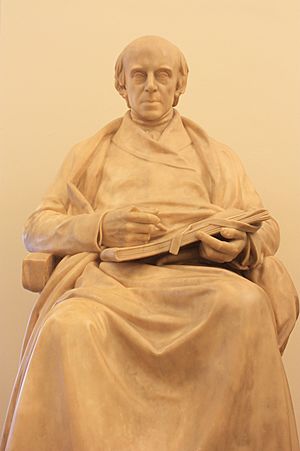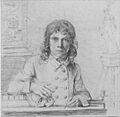John Flaxman facts for kids
Quick facts for kids
John Flaxman
|
|
|---|---|
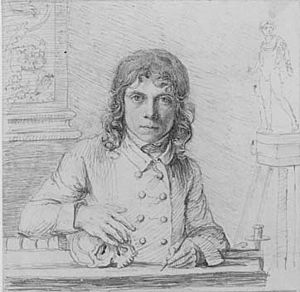 |
|
| Born | 6 July 1755 York, England
|
| Died | 7 December 1826 (aged 71) London, England
|
| Nationality | British |
| Known for | Sculpture and engraving |
| Movement | Neoclassicism |
John Flaxman (born July 6, 1755 – died December 7, 1826) was a famous British sculptor and draughtsman. He was a very important artist in the Neoclassicism movement in Britain and Europe. Early in his career, he made models for Josiah Wedgwood's pottery company. He also lived in Rome for several years, where he created his first book illustrations. Flaxman was also well-known for making many monuments for graves.
Contents
Early Life and Artistic Beginnings
John Flaxman was born in York, England. His father, also named John, was a moulder who sold plaster casts in London. When John was just six months old, his family moved back to London. He was a sickly child with a large head and high shoulders. His mother died when he was nine, and his father remarried.
John didn't go to school much. He taught himself by drawing and making models from his father's plaster casts. He also read classical books to learn more.
Discovering His Talent
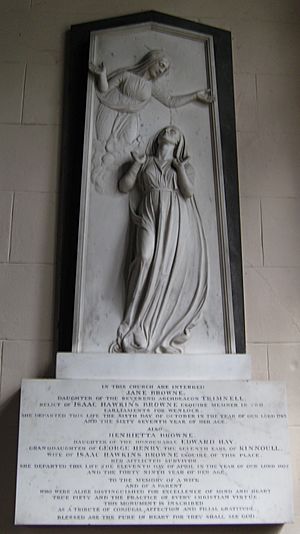
His father's customers helped him a lot, giving him books, advice, and later, jobs. Important people like the painter George Romney and a kind clergyman, Anthony Stephen Mathew, supported him. At the Mathews' house, young Flaxman met famous thinkers and artists like William Blake and Thomas Stothard, who became his close friends.
When he was 12, he won his first art prize for a medallion. At 15, he won another prize and showed his work at the Royal Academy of Arts. In 1770, he became a student at the Royal Academy and won a silver medal. Even though he didn't win the gold medal in 1772, he kept working hard.
He made many wax and terracotta models, including a figure of Neptune. However, he found it hard to get regular work from private clients at this time.
Working with Wedgwood Pottery
From 1775, John Flaxman worked for the famous potter Josiah Wedgwood. His father had also worked for Wedgwood. Flaxman created detailed reliefs for Wedgwood's special pottery, like jasperware. He would make these designs in wax, and then they would be cast for production. He was inspired by ancient Greek vases.
Some of his well-known designs for Wedgwood include Apotheosis of Homer (1778) and Hercules in the Garden of Hesperides (1785). He also made many small reliefs, with The Dancing Hours (1776–8) being very popular. He designed busts, portrait medallions, and even a chess set.
Creating Grave Monuments
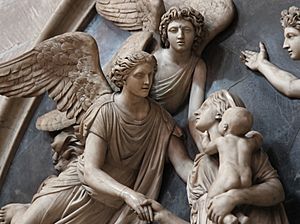
By 1780, Flaxman also started earning money by sculpting monuments for graves. His early works included memorials for Thomas Chatterton in Bristol (1780) and Mrs. Morley in Gloucester Cathedral (1784). For the rest of his career, these memorial reliefs were a big part of his work. You can find them in many churches across England.
His best monuments were admired for their emotional depth and simple beauty. They combined a Greek sense of design with a feeling of warmth and innocence.
Marriage and Family Life
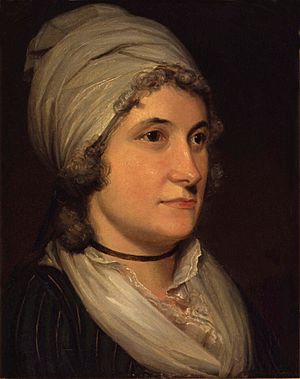
In 1782, when he was 27, Flaxman married Anne ("Nancy") Denman. She was well-educated and helped him throughout his career. They lived in Wardour Street in London and often spent their summers with the poet William Hayley in Sussex.
Flaxman was very fond of Nancy's family. He trained her younger sister, Maria, to be a sculptor. He also hired Nancy's brother, Thomas Denman, to work in his studio. After Flaxman's death, Thomas Denman finished many of his sculptures.
Time in Italy
In 1787, Flaxman and his wife traveled to Rome, Italy. Wedgwood helped pay for their trip. In Rome, Flaxman oversaw other modellers working for Wedgwood, though he no longer made designs for the company himself. His sketchbooks show that he studied not only ancient Roman art but also Medieval and Renaissance art.
Famous Book Illustrations
While in Rome, Flaxman created the first of his famous book illustrations. These drawings made him well-known across Europe. Even the famous writer Goethe called him "the idol of all dilettanti" (meaning, admired by all art lovers).
He designed illustrations for the works of Homer (published in 1793), Dante (published in 1807), and Aeschylus. These were all engraved by Piroli. Flaxman's 111 illustrations for Dante's Divine Comedy inspired artists like Goya and Ingres. They were also used by art students in the 19th century.
Flaxman had planned to stay in Italy for only two years. However, a difficult commission for a marble sculpture called Fury of Athamas kept him there longer. By the time he returned to England in 1794, after seven years, he had also finished Cephalus and Aurora, a marble group based on a story by Ovid. This sculpture is now in the Lady Lever Art Gallery in Liverpool.
Back in England
When the Flaxmans returned to England, they settled in Buckingham Street, London. Soon after, Flaxman spoke out against the idea of creating a huge art museum in Paris filled with art taken from across Europe. However, he later visited Paris himself to see the art that had been gathered there.
While still in Rome, Flaxman had sent models for several monuments back to England. These included a relief for the poet William Collins in Chichester Cathedral and a statue for Lord Mansfield in Westminster Abbey.
Public Recognition and New Works
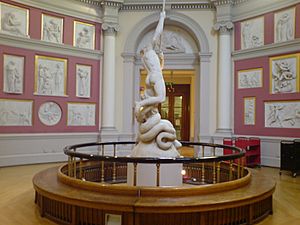
In 1797, he became an associate of the Royal Academy of Arts. He showed his work there every year. Sometimes he exhibited large public monuments, like those of Pasquale Paoli (1798) or Captain Montague (1802) for Westminster Abbey. He also created statues of Nelson and Howe for St Paul's Cathedral.
More often, he made smaller memorials for churches, often showing acts of mercy or scenes from the Bible in low relief. His work was very popular, and he didn't charge extremely high prices. He also suggested a grand monument to be built on Greenwich Hill, a 200-foot-high figure of Britannia, to honor British naval victories.
Later Career and Teaching
In 1800, Flaxman became a full member of the Royal Academy. In 1810, he was made the Professor of Sculpture, a new position. He was a careful and wise teacher, and his lectures were often printed. He was one of the few people at the time who truly appreciated the sculpture of the Middle Ages.
Some of his most important sculptures from this period include the monument to Mrs. Baring in Micheldever church (1805–1811) and monuments for Joshua Reynolds (1807) and Sir John Moore (1813). He also created a monument for Matthew Boulton (died 1809) in St. Mary's Church, Handsworth, Birmingham. This monument includes a marble bust of Boulton.
The Elgin Marbles and Other Projects
Around this time, there was much discussion about the sculptures from the Parthenon in Athens, which had been brought to Britain by Lord Elgin. These were known as the Elgin Marbles. When Flaxman first saw them in 1807, he advised against trying to restore them. His strong support helped convince the government to buy the sculptures in 1816. His designs for the Theatre Royal, Covent Garden, show the direct influence of these marbles on British sculpture.
In his later years, he also designed work for goldsmiths, including a cup for John Philip Kemble and the famous "Shield of Achilles" for Rundell, Bridge and Rundell. He also wrote several articles about art and archaeology for Rees's Cyclopædia.
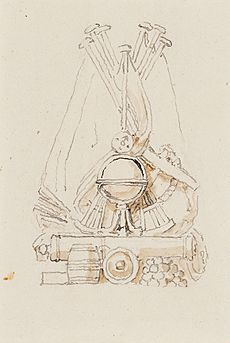
In the last six years of his life, Flaxman designed decorations for the outside of Buckingham Palace. Some of his drawings for this project are now kept by the Royal Collection Trust.
In 1820, Flaxman's wife died. Her younger sister, Maria Denman, and his own sister, Maria Flaxman, continued to live with him. He kept working hard. In 1822, he gave a lecture in memory of his friend, the sculptor Canova, who had recently passed away.
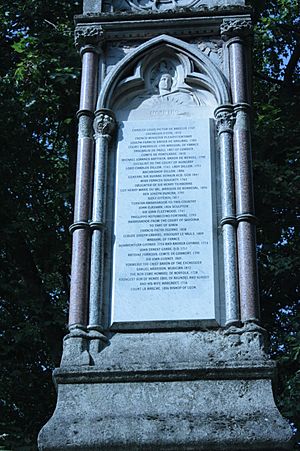
John Flaxman died on December 7, 1826, at the age of 71. His name is listed on the Burdett-Coutts Memorial Sundial in Old St. Pancras Churchyard, marking important lost graves.
Flaxman Terrace in Bloomsbury, London, is named after him.
How His Studio Worked
Most of the actual carving of Flaxman's sculptures was done by his assistants. Some art experts believe that because of this, some of his finished marble works might seem a bit less lively. However, his plaster models, which were cast from his own clay designs, often show his sensitive artistic touch.
Early in his career, Flaxman would make small models. His assistants would then make these models much larger for the final marble versions. This sometimes caused problems. So, for his later works, he created full-sized plaster versions for his employees to work from.
Images for kids
See also
 In Spanish: John Flaxman para niños
In Spanish: John Flaxman para niños


